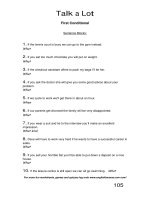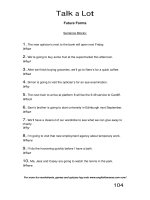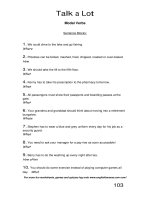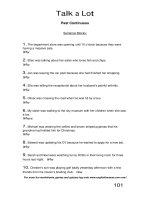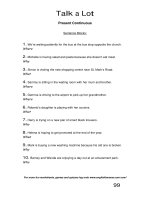talk a lot information exchanges instructions
Bạn đang xem bản rút gọn của tài liệu. Xem và tải ngay bản đầy đủ của tài liệu tại đây (16.59 KB, 2 trang )
Talk a Lot
How to Use
Information Exchanges – Instructions
Information exchanges are a terrific way to get students talking because they can only be
completed by students asking each other questions. The objective of each information
exchange is for students to find out and write down the information that is missing from their
handout, but which their partner has. This objective is complemented by a super-objective –
or additional purpose – which is topic-specific. For example, in the “Crime” information
exchange in Book 2, students have to find out information about possible suspects in a
murder investigation, by exchanging information with their partners – so that they can make a
deduction as to who dunnit! In “The Human Body” information exchange – also in Book 2 –
students have to find out details about the physical appearance of four different people, so
that they can decide who they would most like to swap bodies with for a day… and so on!
Students should work with a partner and not look at their partner’s handout. If they need to
know a spelling or look up a word in their dictionary their partner could write the spelling on a
separate piece of paper, or better still say it out loud. Do discourage students from simply
reading and copying from their partner’s handout – this is Talk a Lot, not Write a Lot!
This activity is also great for practising and consolidating question forms and answers. The
teacher should monitor the students as they work and encourage correct question forms, or
spend time looking at the question forms for each information exchange on the board, for
example:
Topic (from Book 2): “Cars – Buying a Used Car” – sample questions and answers
Student A: “What make is Used Car 1?”
Student B: “It’s a Citroën.”
Student B: “What model is Used Car 1?”
Student A: “It’s a C4 Picasso.”
Student A: “What colour is Used Car 2?”
Student B: “It’s brown and grey.”
Student B: “How many miles has Used Car 2 done?”
Student A: “It’s done 126,001 miles.”
Student A: “What kind of fuel does Used Car 2 use?”
Student B: “Petrol.”
Student B: “How many doors has Used Car 3 got?”
Student A: “It’s got five doors.”
Student A: “Has Used Car 4 got a CD player?”
Student B: “Yes, it has.”
For Book 2 there is a complete list of sample questions and answers for each topic’s
information exchange activity in the answer section at the back of the book, along with a
completed grid for each activity. For the topics in Book 3 the answers and additional
information is included with each handout.
Note: teachers and/or students can make their own information gap activities by using the
blank template on p.6.3.
For more fun worksheets, games and quizzes log onto www.englishbanana.com now!
Talk a Lot Elementary
English Banana.com
6.1
Talk a Lot
How to Use
Information Exchanges – Instructions
Assessment
Assessment is performed by the teacher checking and correcting during the task, listening for
errors that can be dissected later on in a group feedback session, giving individual as well as
group feedback, and referring students back to:
a) the grammar they are learning from forming the sentence blocks, and building
sentences
b) the pronunciation work they are doing using the techniques of connected speech and
the IPA
Each student’s achievement in this activity is also recorded as part of their overall lesson
score (for both accuracy and effort) by the teacher on their course report.
For more fun worksheets, games and quizzes log onto www.englishbanana.com now!
Talk a Lot Elementary
English Banana.com
6.2



